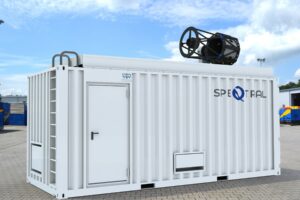
What can you do with 10Gbps broadband? That’s the first question that comes to mind when you read the news today that the Singapore government is pumping S$100 million into a speed upgrade for the country’s nationwide fibre optic network.
In the simplest terms, the answer to the 10Gbps question is “we don’t know”. Just like when the first fibre optic cables were laid to homes almost two decades ago in Singapore’s last big upgrade, there isn’t a solid idea of what the faster network can do yet.
Some commentators and industry experts have suggested video streaming, Zoom calls, games, smart home appliances and even virtual reality (VR) experiences like on Apple’s new headsets.
In truth, even with all these services running at the same time, you will struggle to use up the 1Gbps pipe common in more than 85 per cent of Singapore households today. 10Gbps is, on paper, 10 times faster.
Speaking to reporters this morning, Minister for Communications and Information, Josephine Teo, said the speed upgrade will allow Singapore to be “future-proof” for new applications, while enabling businesses to be competitive in the future by being plugged in early.
The S$100 million investment will help fund the network equipment that telecom operators would need for the speed upgrade, she added.
Upgrading works will run from the middle of this year to 2026. The Infocomm Media Development Authority (IMDA) expects half a million households to sign up for 10Gbps services by 2028. That’s almost a third of the 1.4 million households today.
Over the years, some telcos have rolled out 10Gbps fibre broadband. In the past year, with the technology maturing, many have started offering attractive bundles to bring users onboard.
So, why should the government subsidise these telcos? The IMDA says its investment would catalyse more 10Gbps offerings and possibly lead to more competitive prices for consumers.
What would be considered competitive? Asked by Techgoondu today, the IMDA folks did not want to specify, but you suspect current 1Gbps prices would be a good gauge.
In other words, if the government investment could eventually get 10Gbps prices down to about S$40 a month, then you’d expect more consumers jumping onboard.
You can see this as a bottle half-empty or half-full. Yes, the government could have waited for the market to get more competitive on its own. There are ample signs of late, thanks to more attractive 10Gbps bundles being rolled out.
Yet, there’s nothing like a cash incentive to get telcos moving faster. If you are one of the telcos, you don’t want to be left behind, only offering 1Gbps when your rivals have got a shot in the arm from the government to roll out a faster 10Gbps service.
Don’t forget that this upgrade isn’t like the big one back in the 2000s, when the government decided to dig up the roads islandwide and run cables up risers in high-rise buildings to hook up every home, school and office with new fibre optic cables.
Back then, it had pumped in S$1 billion for this Next-Gen National Broadband Network (NGNBN), ripping up not just the roads but the duopoly of Singtel and StarHub by granting open access to a new high-speed network in a regulated manner.
This time, the groundwork, literally, has been laid. The fibre optic cables are already in the ground and in every home, so the upgrade is simpler. Telcos have to set up new switches, routers and other network equipment at the telecom facility rooms where they place their gear.
All this, of course, doesn’t answer the big question: Why should Singapore build something that’s not going to be used fully for some years?
The same question has been asked over the years as telecom infrastructure is upgraded. If Singapore were to stay ahead as a regional hub, its network has to be top-notch and ahead of time.
Often, the highway must be built ahead of the anticipated traffic. Think back to the pandemic and it’s clear how important Singapore’s fibre network had helped people and businesses carry on with life.
So, what’s the downside this time, when the government is once again putting in money? After all, it’s getting telcos to upgrade and compete for consumers through lower prices and faster speeds.
What needs highlighting are the many bottlenecks that still hamper a “real” or true 10Gbps experience. If there’s hardly any difference between 1Gbps and 10Gbps, consumers would stick with cheaper 1Gbps plans, which you can still expect to be around.
Look at the situation with 4G and 5G mobile services, for example. Without a big difference in the way you get your e-mail, YouTube or video calls on either mobile network, you’d be hard pressed to move out of a S$10- or S$20-a-month 4G service for a costlier 5G one.
For home broadband, users have to get help to get “proper” 10Gbps. After all, pushing 10Gbps into each home is just the first step – having your devices connected properly could be a bigger hurdle.
You will need not just the latest Wi-Fi 6E or even Wi-Fi 7 gear to get somewhere close to 10Gbps speeds but a proper setting up of Wi-Fi access points at various parts of an apartment or house to maximise the wireless signal and connection.
Then, there is structured cabling, which is needed for consistent 10Gbps speeds. You’ll need to run Cat 6 network cables in your home, which isn’t a trivial undertaking.
Sure, Cat 6 cables are now built into new HDB apartments, but what about older ones? Many users might need help from home network experts and computer technicians to get their homes well wired up for 10Gbps broadband.
So, while the S$100 million investment is a great start to bring prices down to more attractive levels, the experience will eventually have to catch up.
Perhaps in the next four to five years, it will, like the now-common 1Gbps fibre broadband that’s considered basic today. When 10Gbps broadband becomes the same utility available at an affordable price, it will have succeeded.






